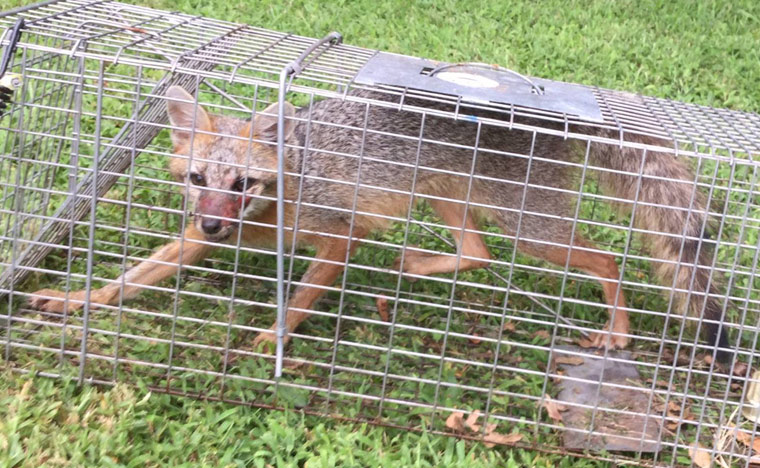- info@wildlife-removal.com
Call us for help in your town
Wildlife Removal Education
How to Catch a Fox
Need fox removal in your hometown? We service over 500 USA locations! Click here to hire us in your town and check prices - updated for year 2020.
I personally believe that we are past the era of old-time leghold traps. Fox are like dogs. We all love dogs, right? A leghold trap is just an inhumane way to go, and there's no way
to justify otherwise. It's not hard to trap a nuisance fox in a cage trap and relocate it. I know that's not a perfect way to go for several reasons, but it's better than a leg hold,
I believe. And don't forget: if you have trouble and want to hire a pro like me, someone with experience,
click on this map of Professional Wildlife Removal Companies, and you'll find an expert in your town or city.

The fox is an elusive, beautiful animal found in many areas around the world. Similar to a dog in appearance, the fox boasts a heavy coat and weighs anywhere from eight to twenty pounds. Many varieties of foxes live around globe, but the most common troublemakers are the red fox and the grey fox. Most people do not have issues with foxes unless raising chickens, food-quality rabbits, or other small mammals. Foxes are opportunistic, so a warm chicken house might as well have a welcome sign out front.
Identifying a fox as the culprit for missing fowl is not always easy. Birds killed by the fox are often carted away and eaten in the den, and if not, the remains are usually buried. Foxes will eat carcasses, preventing the original cause of death from being revealed. Regardless of whether or not you see a fox running off with your chicken, holes in your fencing will be enough of a sign to know you have a stealthy predator on your hands.
Wire fencing, as long as it is buried underground, can be helpful to exclude foxes from entering a farm. The wire mesh should be made of a heavy gauge metal. Foxes can chew through and break thin wire. Electric fencing, if placed at appropriate level, can also be a useful deterrent. Removal of any animal carcass waste from commercial processing should be done immediately to eliminate enticing aromas.
Noise harassment is usually ineffectual against foxes. Radios, sound guns, ultrasonic devices, and static emitters may work for a few days, but eventually the fox will become immune to the effects. Fancy lighting, such as strobe lighting is also a very temporary method of deterring a fox. Like all animals, once a pattern is discerned in the repellent method, that animal’s fear of that item will vanish.
You can try to catch a fox yourself, though caution is usually emphasized in this area. A fox can adapt to trapping methods quickly, and an inexperienced trapper can inadvertently cause a fox to recognize and avoid traps in the near future. If you are going to trap a fox, select a live-trap or a body-gripping trap that will quickly kill the fox instead of maim it. The next step will be to locate an appropriate place for the trap to be set. Foxes that are nuisances generally live near human dwellings. Plots of debris, old hay bales, or dense areas of brush are often ideal locations for a den. A trap can be set near a carcass or baited to lure the fox inside. Take care to conceal the trap as much as possible. Grass, leaves, branches, and the like will help make the trap appear less out of place. Wear gloves or scent cover to prevent leaving a scent mark behind. Because foxes are quick learners, do not place your bait inside the trap immediately. Place bait outside the trap and allow the fox to take it. The next day, place the bait closer or inside the trap, but not far enough to set the pressure bar. When you are certain the fox has returned multiple times and taken the bait, you are ready to place the bait with the intent to catch the fox.
Once you have the fox, you can release it away from your property in an appropriate area. Some animals, such as foxes, do not always respond well to relocation. Competition with other foxes, lack of food, and lack of shelter can make a relocated fox’s chances for survival less than desired. If relocation isn’t an option, a wildlife professional can be called to humanely euthanize the animal.

For more info, got back to my Fox Removal page.


















